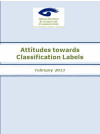UMR Research included questions in an online omnibus in January 2013 to help us understand public attitudes to classification labels and whether people are guided by them when making viewing and gaming choices for themselves and younger people in their care.
Key Results
The research shows that many New Zealanders treat classification labels as (fairly strong) guidelines rather than as absolutes, at least when it comes to deciding what to allow children to watch and play in their own homes.
- 34% claim that they always follow the classification labels when deciding whether to show or give a game to someone under the age of the classification label.
- 44% say they usually follow the classification labels, except in some circumstances.
- 18% declare that they typically do not follow the classification labels, except in some circumstances.
- 5% never pay attention to the classification labels.
62% of New Zealanders therefore pay at least some attention to the classification labels when deciding what to give or show to underage people, but will make exceptions.
- People in this group are relatively likely to be Wellingtonians (71%) or under 30 years old (70%).
- 67% of parents are in this camp, with 53% saying that they generally follow the classification labels but make some exceptions.
Questions exploring the circumstances where people will choose to accept or ignore the classification labels demonstrate that the exceptions largely reflect personal judgement.
- Those who say they generally follow the classification labels except in some circumstances often say that they make exceptions when they already know about the content (e.g. because they have seen the film before), when they feel confident that the underage people are mature enough to handle the content, if the film / game has been recommended by someone they trust or if they personally feel that the classification is unjustified.
- Those who generally ignore the classification labels except in some circumstances often mention the perceived maturity of the viewers, what they personally know about the content (especially violence) and if they are looking after someone else’s children.
- Analysis of the verbatim responses also indicates that proximity to the classification age is an important factor – e.g. some might show a 15 year old an R16 film but not an R18.

